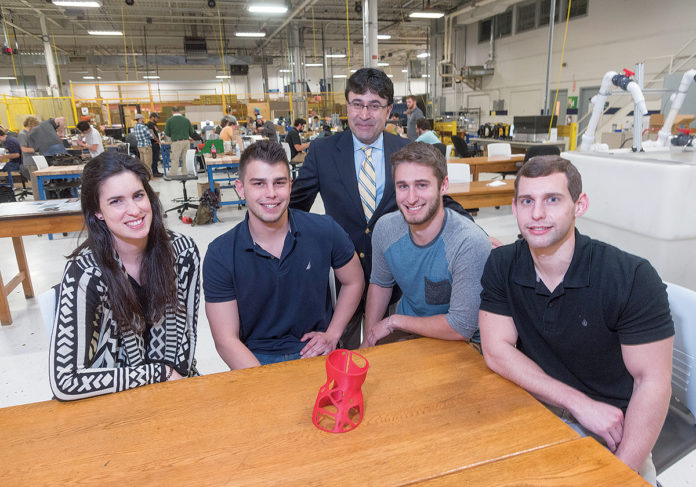The most common daily brace worn for scoliosis, the Boston brace, was created in the 1970s and remains a go-to solution for physicians treating young patients with curvature of the spine.
But not every young teen wants to wear it all day. Using a software system designed by Dassault Systemes, and a challenge to design a better brace, a team of four engineering students at the University of Rhode Island this year created a model for a lighter, more breathable alternative.
The students, as part of URI’s senior capstone class in mechanical engineering, researched scoliosis and interviewed specialists, including the chief of pediatric orthopedics at Hasbro Children’s Hospital in Providence.
For the past nine years, the capstone projects in mechanical engineering have attracted more than a dozen companies in Rhode Island each year. They work with Bahram Nassersharif, a distinguished university professor of mechanical engineering, to devise real design problems for the students to solve.
The course, taken over two semesters, has 91 students this year. By late April, the student teams had completed 25 design projects.
“The program is set up to prepare our students for professional engineering work when they graduate by actually working on a real-world, engineering design problem, which we elicit from companies that we work with,” Nassersharif said.
This year, companies participating included Amgen Inc., ChemArt, Hasbro Inc., Magnetic Seal Corp. and Vibco Vibrators.
The student team that worked on the scoliosis brace began with researching the disorder, and then asked several orthopedic physicians what they should improve. The team members included Dan Cross, Thomas Brey, Gabriella Devine and Christopher Viveiros, according to the university.
They quickly learned that doctors were most concerned about the comfort of the device.
“If it is uncomfortable, the patient won’t wear it,” said Brey.
Said Cross: “They said the biggest thing was those Velcro straps. Every parent could tell that Velcro sound of their kid pulling off the brace because they got tired of wearing it.”
The students evaluated the Boston brace, which covers the full torso, from chest to hip, and secures with sturdy Velcro-backed straps, as well as the Providence brace, often worn at night. They decided to focus on the Boston brace for their work, and considered ideas for how to make it lighter and more breathable. Eventually, they created a design that uses less plastic, and has more breathability.
The Dassault Systemes software, an engineering software, is designed for optimization, explained Cross. Once they entered the loads required on the brace points, it shaved off the unnecessary plastic.
The brace design they created uses more of a lattice-style form.
The brace essentially works by applying pressure to points of the spine.
The students produced a 1/25 scale of their new design using a 3-D printer, as requested by Dassault in its assignment.
The next step for the team is to bring the product back to the physicians for their evaluation, to see if it’s something they think should be pursued.
The process of research, design and evaluation, attempting to solve real problems faced by companies, is part of the professional life of an engineer, explained Nassersharif.
The companies that get involved with URI typically identify a problem they’re interested in resolving, and the professor determines if it can be applied to the teaching and university setting. “So, it is adjusted correctly for the skills of the students and what they can and cannot do,” he said. “There is a dialogue that takes place.”
The projects and designs don’t always end simply with models or concepts. Often, companies take the ideas or designs and move on with them. Some have turned into products, Nassersharif said.
Amtrol Inc. has used some capstone-originated designs in its water-filtration tanks, he said, and Hasbro pursued a conceptual product that students suggested to help reduce noise on its Nerf Blaster for European markets, which have a lower noise allowance.
“We designed that and gave it to them. They did further design work on it, before it goes into a product, so they can get into that market,” Nassersharif said.
For the students, all of this practical experience leads to job offers. The yearlong process is impressive to potential employers, the professor said.
“The students tell me when they go to job interviews, they spend more than half the time talking about their senior capstone project with the prospective employers,” Nassersharif said. “It’s more about engineering skills. How did you solve that problem? How did you make the Nerf Blaster more silent? … It’s about problem-solving.”













